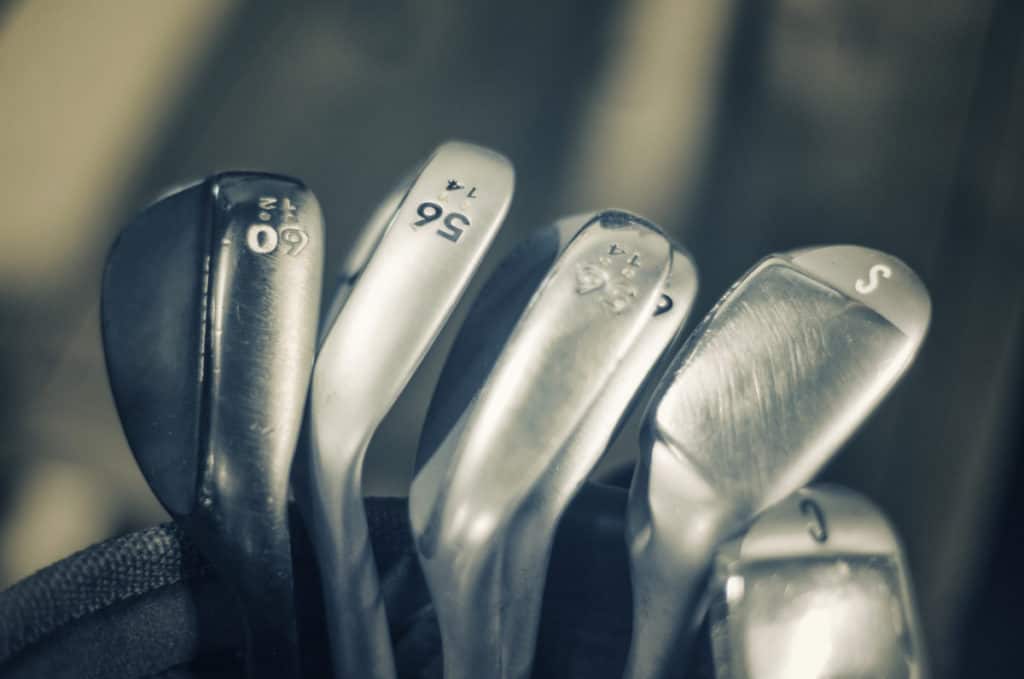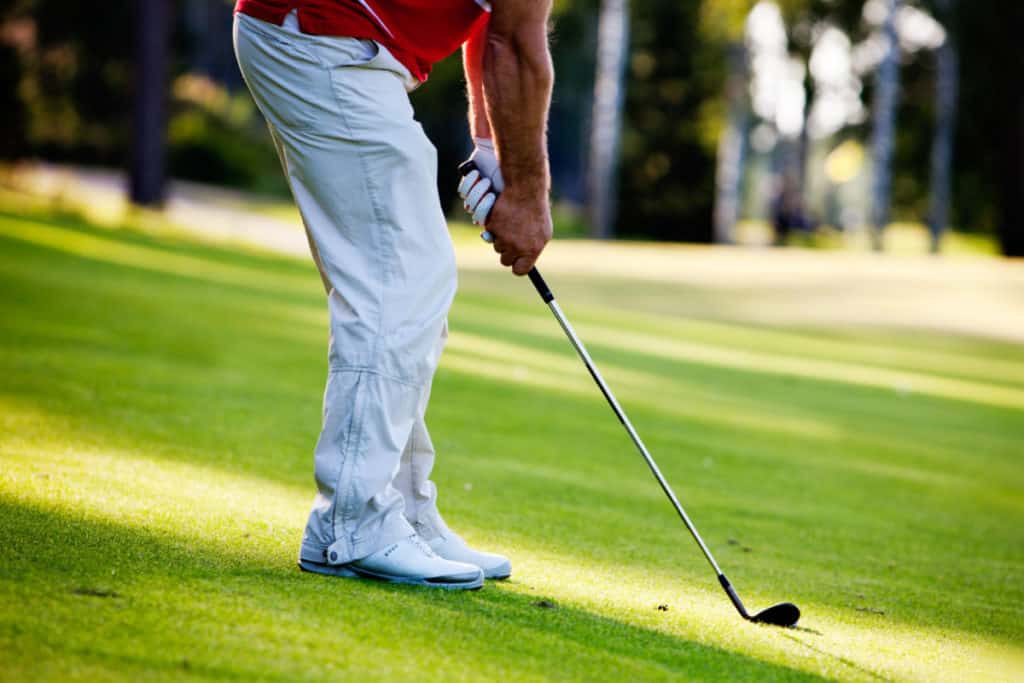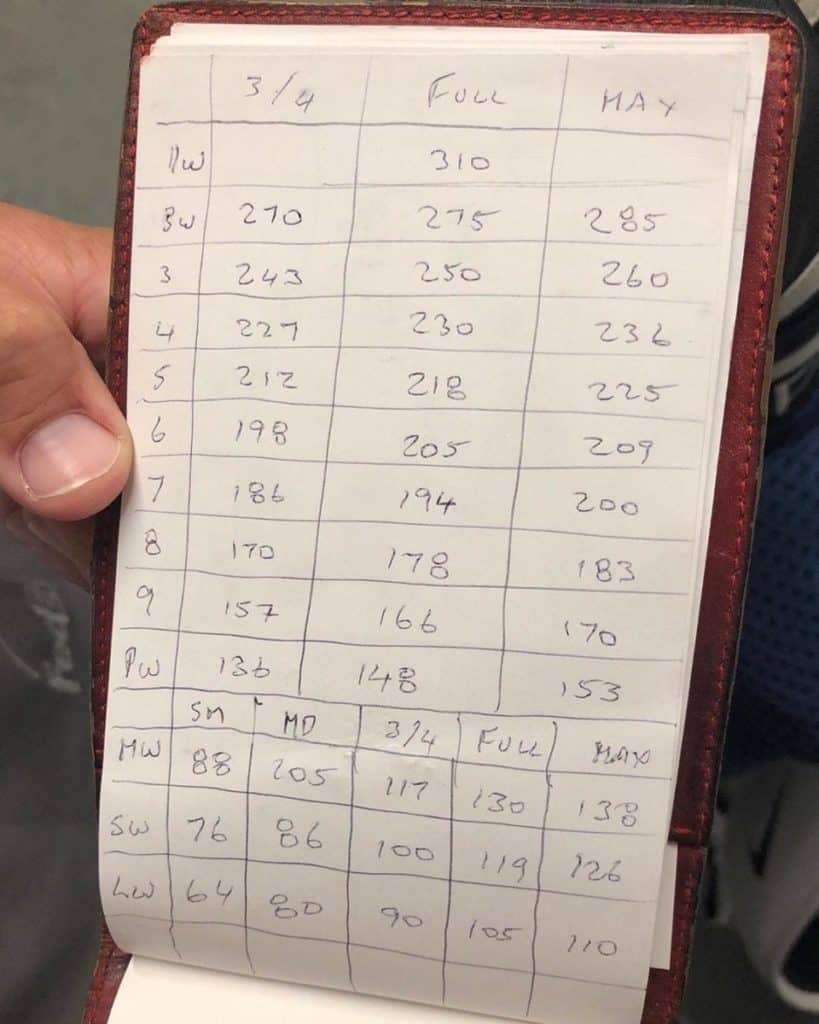How Far Should You Hit Your Wedges? Be Sure to Fill the Gaps!
This post contains affiliate links from which Golfing Focus earns a commission (at no cost to you).

When golfers start talking about how far they hit the ball chances are they will be talking about their drives. But if you are serious about getting better reducing the number of strokes it takes you to get the ball into the hole from 120 yards in is vital.
And for those short shots, your wedges will be the key clubs so it is very important you know how far you hit them.
So how far should you hit your wedges? Different wedges have different degree lofts and on average will typically be hit by the average male and female golfer within the following ranges:
| CLUB | LOFT (Degrees) | MEN (Yards) | WOMEN (Yards) |
| Pitching wedge | 45-49 | 85-115 | 50-65 |
| Gap wedge | 50-54 | 75-95 | 40-55 |
| Sand wedge | 55-59 | 60-80 | 30-45 |
| Lob wedge | 60-64 | 45-65 | 20-35 |
The skill level of the individual golfer clearly is the key factor in where an individual golfer will fit within these ranges and indeed beginners will often find they do not achieve any of these distances.
But while golfers will frequently get hung up on distance and how far individual clubs go it is ‘distance control’ which is crucial for wedge play.
And with the short game accounting for more than 50% of the shots golfers will play improving your wedge play should be one of the first steps you take if you want to lower your scores.
Pro tip: Testing by the Titleist Vokey R&D team found that a new wedge can generate up to 2000RPM more than one which has played 125 rounds. So if your wedges are more than 3 years old it’s worth inspecting to see if the grooves are wearing down and starting to affect the amount of spin and control you are getting with your wedge shots.
[If you are interested in a wedge upgrade you can check out the best wedges according to Golf.com, Golf Digest and Today’s Golfer on at the PGA Tour Superstore now.
- Titleist Vokey Design SM9
- Callaway Jaws MD5
- Taylor Made Milled Grind 3.0
- Cleveland CBX2
- Cleveland RTX Zipcore
- Ping Glide 4.0
- Mizuno T22]
Which Wedges Should I Carry to Cover What Distances?
Your average golfer will not hit many greens in regulation during a round. Golfers with a handicap of 10 and over will hit less than 7 greens out of 18 in regulation on average while even single figure golfers will only hit between 8 and 11 greens each round.
That inevitably means your average golfer will be hitting a lot of shots from 120 yards and less so having clubs that let you cover those distances is going to be crucial to scoring well.
A standard pitching wedge has a loft of 46 degrees while a standard sand wedge will today have 56 degrees of loft. If you therefore only carry those wedges that can leave a distance gap between how far you can hit each of those clubs which can make it harder to hit the golf ball the correct distance for those crucial short shots.
Most golf teachers therefore recommend that you carry 3 wedges – a pitching wedge, a gap wedge and a sand wedge – and have approximately between 4-6 degrees of difference between them.
For example, if you have a 46-degree pitching wedge you should consider adding another 2 wedges – a gap wedge with between 50 or 52-degree loft and a sand wedge with 54 or 58-degree – depending on your choice of either 4 or 6 degree spacing between your wedge lofts.
I can’t begin to tell you how crucial gapping in wedges is. Most everyday players have little idea about the loft gaps with their wedges. They just take a pitching wedge and sand wedge and go.
Titleist master wedge craftsman Bob Vokey
Some players will go one step further and carry a lob wedge as well to give them even more options when it comes to the distances they can comfortably cover with their wedges. Given the maximum number of clubs a golfer can carry though is 14 that choice will require a compromise on the longer clubs they have in their golf bag and mean they will not carry a 3 iron or 4 or 5 wood or equivalent hybrid.
Whatever wedges you choose will inevitably depend on your own game and preferences. Having specific clubs for your short yardage shots that ensure you can comfortably cover a good range of distance is going to be very important to good scoring.
So make sure you don’t just keep blindly playing with whatever wedges you have. Check you far you hit your current wedges and see whether you need to make any changes to make sure you’ve got your short distances covered.
How to Measure How Far You Hit Your Wedges
A general guess about how far you hit your wedges is not going to be good enough if you really want to improve your short game and get your scores down.
It is a straight forward process to measure golf shot distance and in this day and age there are also lots of tech options available which makes it even easier.
To get the best measurement of how far you hit your wedges head to somewhere where you can walk and collect your golf balls. Take your sand wedge, hit 10 shots towards a target and then measure out how far you hit each one.
If you hit a really bad shot just do not count it and if you can use the same ball for all 10 shots that is even better.
The most accurate way to measure each shot is to use a GPS measuring device, smartwatch or a laser range finder but if you do not have any of those simply pace out the distance to each shot and write down how far you hit each shot.
The final step is then simply to calculate the average distance you hit the 10 shots and keep a note. Then simply repeat the process for each of your wedges and you will be ready for your next game and clearer on which wedge will work best for your short shots.
If you want to get even more precise you can also keep a note of the shortest and longest distances you hit the ball with each wedge to give you a range for each club.
If this process isn’t possible or easy for you to do you can try hitting only 3 balls in a row when the course is quiet or heading to your local driving range and using the yardage markers there to give you a rough idea of how far you hit your wedges. This will be less precise but still useful and an improvement on any existing guesswork you are currently basing your wedge distances on.
The Single Best Tip to Hit Your Wedge Those ‘Inbetweener’ Distances

No matter how many wedges you carry in every round you will be faced with a wedge shot which is ‘inbetween’ the distance your full wedge shots carry.
If you hit a full gap wedge approximately 90 yards on average you can guarantee the first wedge shot of the day you have to play will be 93 yards.
How well players handle these ‘inbetween’ yardages separates the best from the rest and the great wedge players are best equipped to adjust their shot to carry whatever distance they are faced with irrespective of how far their full wedges carry.
When faced with these ‘inbetween’ shots a lot of amateurs will try to swing more slowly resulting in them decelerating at impact and frequently hitting a poor shot or even duffing the ball.
One single and effective tip is simply to grip lower down the club and swing normally. Gripping down an inch can take off 5 yards and for some players gripping down the entire length of the grip takes as much as 20 yards off their wedge.
This one simple change can help a great deal when faced with inbetweener differences and stops players from falling victim to the fatal mistake of decelerating through the ball. Swinging positively is the only way to achieve good contact with the ball and hit more predictable wedge shots.
How Far Do the Pros Hit Their Wedges?
Professional golfers will typically carry 3 or 4 wedges with lofts of between 46 and 60 degrees. What combination of wedges they carry can change depending on the course design and conditions. Players, such as Phil Mickelson, can very occasionally a 5th wedge to give them even more options for shots inside 125 yards.
The average distance PGA Tour professionals hit a pitching wedge is 130 to 135 yards, 115 to 120 yards for a sand wedge and between 75 and 95 yards for lob wedges. Players on the LPGA Tour by comparison hit pitching wedges between 105 and 110 yards on average and sand and lob wedges between 75 and 90 yards.
What is most interesting about professional players’ approaches to how far they can hit their wedges is the accuracy with which they detail how far they can hit each of their wedges with a variety of different swings.

Take a look at the picture of Brooks Koepke’s yardage book. Here you can see the detail with which he goes when it comes to wedge play. Carrying 4 wedges – a Srixon ZX7 46 degree pitching wedge and 3 Cleveland RTX Zipcore Tour wedges with 52, 56 and 60 degrees of loft (Check here to find out the latest price at PGA Superstore) – he has details of how far he can each club with between 3 and 5 types of wedge shot.
His sand wedge, for example, can let him cover a range of distances between 76 and 126 yards depending on the type of shot he decides to play – a smooth, medium, 3/4, full or maximum swing. His mid wedge allows him to cover between 88 and 138 yards while his lob wedge can go anywhere between 64 and 110 yards.
In short, he can cover 18 different precise distances with his 4 wedges. That clearly greatly reduces the number of ‘inbetweener’ yardages he is likely to face thereby giving him even more chances to get the ball close from those crucial short distances.
Final Thought
Whatever distance you hit your wedges the key is not to get hung up on how far you hit them compared to everyone else.
Inside 125 yards it is all about direction and control and it is more important to hit your wedges reliably rather than far. Good controlled wedge play can cover up a multitude of golfing sins on your off days and make the days you are firing on all cylinders even better!
More top articles related to this topic:
- Should All Your Wedges be the Same? Focus on Gaps & Variety
- Should All Your Wedges Match Your Irons? Consistency is Key
- What are the Best Wedges for Spin? You Need to Get Into the Grooves
- What Wedges Do the Pros Use? Top 100 PGA Tour Player Analysis
- What Loft Wedges Should You Carry? Use Distance & Variety to Decide
- Good Putting Numbers – It’s About 3 Putts Not Putts per Round
- Going the Distance? How Far Should Beginners Hit A Golf Ball?
- How Far Do Pro Golfers Hit Each Club?
- How Far Should You Hit a Driver? FULL GUIDE By Age, Handicap etc.
- How Far Does a 3 Wood vs 5 Wood Go? Tee and Approach Shots!
- How Far Should I Hit My Hybrids? 2 vs 3 vs 4 Hybrid Distances
- How Far Should I Hit My Irons? By Handicap, Age & Swingspeed
- Do Distance Balls Go Further? Marketing Matters
- Do All Golf Balls Go the Same Distance? Physics First
RECENT ARTICLES
LEGAL INFORMATION
This site is owned and operated by Golfing Focus Limited, a private limited company whose registered office is in London, UK. Golfing Focus Limited is a participant in the Amazon Services LLC Associates Program, an affiliate advertising program designed to provide a means for sites to earn advertising fees (at no cost to you) by linking to Amazon.com. Golfing Focus Limited also participates in other affiliate programs with the eBay Partner Network, FlexOffers, CJ.com, Svorn and other sites and is compensated for referring traffic and business to these companies (again at no cost to you).
Our Socials






Leave a Reply